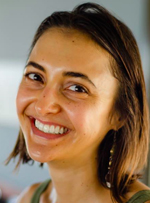Washing the Dead by Michelle Brafman; Prospect Park Books; ISBN: 978-1-938849-52-7, $16.
By Erin Philips

SAN DIEGO — Michelle Brafman is a storyteller: an award-winning short fiction writer, essayist, blogger and former documentary filmmaker. A graduate of UCSD, she is currently based in the Washington, DC area, where she teaches creative writing at The Johns Hopkins MA in Writing Program and the George Washington University, and runs a writing coaching business.
Her debut novel, Washing the Dead, is the story of Barbara Pupnick, a suburban Milwaukee mom who comes to terms with the past – her mother’s affair and her family’s subsequent exile from the beloved Orthodox Jewish community she grew up in – through tahara, the ritual preparation of the body for burial.
Here is my recent interview with her in Q&A format:
Q: Washing the Dead explores many themes: ritual and redemption, religious community, mother-daughter relationships, family history and secrets. How have your own experiences influenced or informed the novel?
A: My experience living in San Diego definitely influenced the novel. A good chunk of the book is set in La Jolla and features the main character Barbara Pupnick’s exile from her Orthodox Milwaukee community. Like Barbara, I moved from Milwaukee to San Diego when I was eighteen, a period of my life when I was figuring out who I was. The first time I drove up La Jolla Shores Drive I felt bludgeoned by the beauty of the coastline, and this exotic landscape combined with an open quality to my California friends made me feel like anything was possible. I decided to both let Barbara taste this freedom and make it her undoing. What I love about writing fiction is this very opportunity to invent a character with her own trouble and family secrets, meaning Barbara’s family history and her relationships with her mother and daughter do not mirror my own. My fascination with the tahara, the Jewish burial rituals, however, led me to the path for Barbara to find a way back to her mother.
Q: “Washing the Dead” was first published as a short story in 2010. Can you describe your creative journey from that story to the novel that exists now?
A: The journey from the short story to my novel was long and winding, seven years total. Before I even wrote that story, I’d written pages about Barbara’s childhood, her exile from her beloved synagogue community, and her mother’s affair that caused it. Once I discovered the tahara I wrote the short story, and soon it became apparent that performing this gorgeous act of compassion could somehow help the adult Barbara loosen that first brick in the wall she’d built between herself and her past. I structured the book around three washings. The mother/daughter conflict of the story evolved throughout the revision process, and the tahara became even more crucial in connecting Barbara with her family legacy, her husband and daughter, and herself.
Q: How has the book been received by the Jewish community? What about non-Jewish readers? Have any reactions surprised you?
A: The book has been received generously by the Jewish and non-Jewish communities. I’ve spoken to secular audiences at bookstores, universities, book clubs, and schools. I’ve also been invited to visit numerous synagogues, sisterhoods, burial societies, and other Jewish organizations. I’m always surprised and humbled by how the particulars of Barbara’s story and religious background resonate with all sorts of readers. Strangers, acquaintances, and friends – Jews and non-Jews – have shared intimate stories about their spiritual journeys and experiences with various burial rituals. And since this is a mother/daughter novel, I’m always delighted and surprised to discover that men relate to this story. But they do!
Q: People always want to know how authors work. What does a typical day look like for you? What kind of writing schedule do you keep?
A: Like many writers, I teach writing. I am also a writing coach and have two kids who are in need of chauffeuring and other maternal services! I’m a morning person, so I write as soon as the kids leave for school, or if I’m on a deadline, I’ll wake up at 5 and work before the house starts humming. These morning hours are what I call prime brain real estate, so I de-activate my Internet and put the pedal to the metal. I also use this time to squeeze in a walk because movement helps me think. After I finish writing, I tend to email, grade papers, meet with clients, put a load of laundry in the dryer, that type of thing. This is all on a good day, though. There are many days when life or my dwindling attention span get in the way, and I don’t get any writing done.
Q: In June you did a reading and signing at Warwick’s in La Jolla. As a UCSD alumna, what do you miss most about San Diego? What’s the first thing you do when you visit?
A: After I graduated from UCSD, I worked for 91X FM Radio for almost five years. Facebook has made it easy to keep up with my college and media friends, and when I saw them at the Warwick’s reading, I realized how very much I’d missed them. I also miss the small things like killer avocados, the way you need both a sweater and sunscreen at any point of a given day, and the feel of salt on my skin. I live in my head these days, and I pine for the active San Diego lifestyle and chips and margaritas from Alfonso’s too. The first thing I do when I visit is commune with the La Jolla Cove, which I’ve come to name my “happy place.”
*
Philips is a freelance writer who specializes in coverage of the arts. You may comment to her at erin.philips@sdjewishworld.com